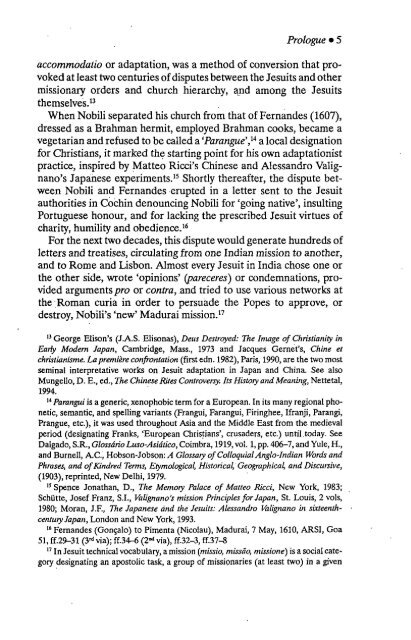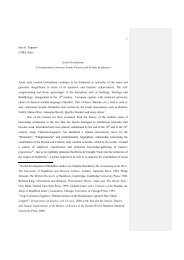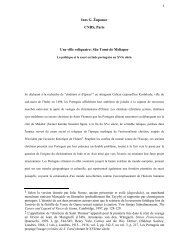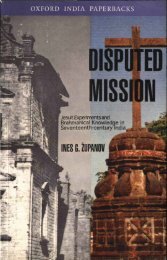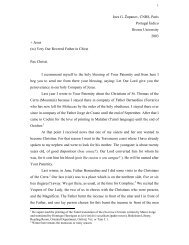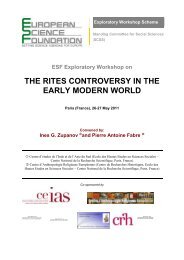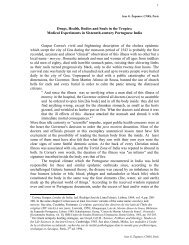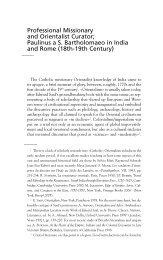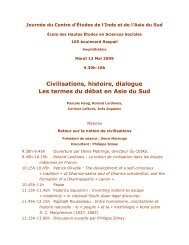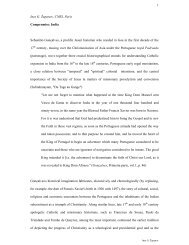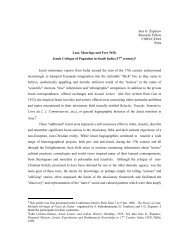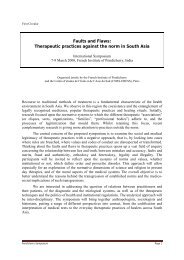INES G. ZUPANOV - Ines G. Županov
INES G. ZUPANOV - Ines G. Županov
INES G. ZUPANOV - Ines G. Županov
Create successful ePaper yourself
Turn your PDF publications into a flip-book with our unique Google optimized e-Paper software.
Prologue • 5<br />
accommodatio or adaptation, was a method of conversion that provoked<br />
at least two centuries of disputes between the Jesuits and other<br />
missionary orders and church hierarchy, and among the Jesuits<br />
themselves. 13<br />
When Nobili separated his church from that of Fernandes (1607),<br />
dressed as a Brahman hermit, employed Brahman cooks, became a<br />
vegetarian and refused to be called a 'Parangue', 14 a local designation<br />
for Christians, it marked the starting point for his own adaptationist<br />
practice, inspired by Matteo Ricci's Chinese and Alessandro Valignano's<br />
Japanese experiments. 15 Shortly thereafter, the dispute between<br />
Nobili and Fernandes erupted in a letter sent to the Jesuit<br />
authorities in Cochin denouncing Nobili for 'going native', insulting<br />
Portuguese honour, and for lacking the prescribed Jesuit virtues of<br />
charity, humility and obedience. 16<br />
For the next two decades, this dispute would generate hundreds of<br />
letters and treatises, circulating from one Indian mission to another,<br />
and to Rome and Lisbon. Almost every Jesuit in India chose one or<br />
the other side, wrote 'opinions' (pareceres) or condemnations, provided<br />
arguments pro or contra, and tried to use various networks at<br />
the Roman curia in order to persuade the Popes to approve, or<br />
destroy, Nobili's 'new' Madurai mission. 17<br />
13 George Elison's (J.A.S. Elisonas), Deus Destroyed: The Image of Christianity in<br />
Early Modern Japan, Cambridge, Mass., 1973 and Jacques Gernet's, Chine et<br />
christianisme. La première confrontation (first edn. 1982), Paris, 1990, are the two most<br />
seminal interpretative works on Jesuit adaptation in Japan and China. See also<br />
Mungello, D. E., ed., The Chinese Rites Controversy. Its History and Meaning, Nettetal,<br />
1994.<br />
14 Parangui is a generic, xenophobic term for a European. In its many regional phonetic,<br />
semantic, and spelling variants (Frangui, Farangui, Firinghee, Ifranji, Parangi,<br />
Prangue, etc.), it was used throughout Asia and the Middle East from the medieval<br />
period (designating Franks, 'European Christians', crusaders, etc.) until.today. See<br />
Dalgado, S.R., Glossàrio Luso-Asiático, Coímbra, 1919, vol. 1, pp. 406-7, and Yule, H.,<br />
and Burnell, A.C., Hobson-Jobson: A Glossary of Colloquial Anglo-Indian Wordsand<br />
Phrases, and of Kindred Terms, Etymological, Historical, Geographical, and Discursive,<br />
(1903), reprinted, New Delhi, 1979.<br />
15 Spence Jonathan, D., The Memory Palace of Matteo Ricci, New York, 1983;<br />
Schütte, Josef Franz, S.I., Valignano's mission Principles for Japan, St. Louis, 2 vols,<br />
1980; Moran, J.F., The Japanese and the Jesuits: Alessandro Malignano in sixteenthcentury<br />
Japan, London and New York, 1993.<br />
16 Fernandes (Gonçalo) to Pimenta (Nicolau), Madurai, 7 May, 1610, ARSI, Goa<br />
51, ff.29-31 (3 rd via); ff.34-6 (2 nd via), ff.32-3, ff.37-8<br />
17 In Jesuit technical vocabulary, a mission (missio, missäo, missione) is a social category<br />
designating an apostolic task, a group of missionaries (at least two) in a given


